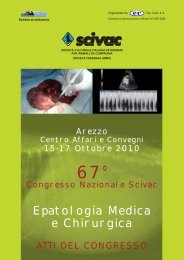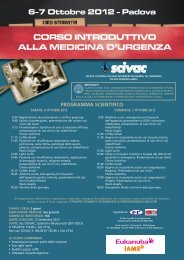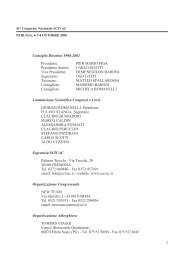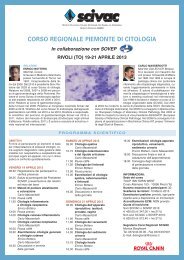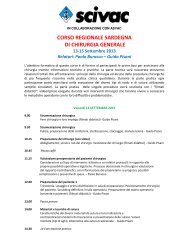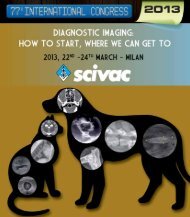58° Congresso Nazionale SCIVAC: Oncologia veterinaria
58° Congresso Nazionale SCIVAC: Oncologia veterinaria
58° Congresso Nazionale SCIVAC: Oncologia veterinaria
Create successful ePaper yourself
Turn your PDF publications into a flip-book with our unique Google optimized e-Paper software.
58° <strong>Congresso</strong> <strong>Nazionale</strong> <strong>SCIVAC</strong> • Milano, 7-9 Marzo 2008 • <strong>Oncologia</strong> <strong>veterinaria</strong> - Alle soglie del III Millennio<br />
USE OF FLOW CYTOMETRY IN THE CHARACTERIZATION<br />
OF ACUTE MEGAKARYOBLASTIC LEUKEMIA (AML-M7)<br />
IN A DOG<br />
UTILIZZO DELLA CITOMETRIA A FLUSSO PER LA TIPIZZAZIONE<br />
DI LEUCEMIA MEGACARIOBLASTICA ACUTA (AML-M7)<br />
IN UN CANE<br />
Fabio Valentini 1 Med Vet, MS; Silvia Tasca 2 Med Vet;<br />
Valentina Caon 3 Med Vet<br />
1,3<br />
Libero Professionista (Roma)<br />
2<br />
Libero Professionista (Padova)<br />
Acute megakaryoblastic leukemia is a rare form of myeloid leukemia first described<br />
in 1931. Megakaryoblastic leukemia in human beings may occur as a<br />
spontaneous disease or as a therapy-related acute leukemia. Cytogenetic abnormalities<br />
of chromosome 21 have been associated with megakaryoblastic<br />
leukemia in human beings. The simultaneous use of several differentiation<br />
markers is required to diagnose this type of leukemia in people.<br />
Megakaryoblastic leukemia is a rare myeloproliferative disorder in domestic<br />
animals. Recently, thanks to the major availability of immunophenotypical<br />
techniques the diagnosis is more accessible. The morphological evaluation<br />
alone in fact has its limitations especially in the study of poorly differentiated<br />
cells. Few reports have described AML-M7 in dogs with the use of flow cytometry.<br />
This clinical case describes the utility of flow cytometry in the characterization<br />
of acute megakaryoblastic leukemia (AML-M7) in a dog.<br />
Clinical case. A 3-year-old, female spayed German shepherd was presented<br />
for severe weakness, lethargy, anorexia and weight loss of several weeks duration.<br />
Physical examination revealed pale mucous membrane, generalized<br />
muscolar athrophy, tachycardia and mild hypothermia. Upon palpation, the<br />
abdomen revealed a splenic enlargement. Initial diagnostic evaluation consisted<br />
of a complete blood cell count (CBC), serum biochemical analysis and<br />
urinalysis. Chest x-rays and abdominal ultrasound were performed as well.<br />
CBC revealed severe anemia (Hct, 11,9%; reference range, 37 to 55%; Hb,<br />
4,4 g/dl; reference range, 12,0 to 18, 0 g/dl), severe thrombocytopenia (9,000<br />
platelets/µl; reference range, 150,000 to 500,000 platelets/µl) and mild leukopenia<br />
(5,600 WBC/µl; reference range, 6,000 to 17,000 WBC/µl). Circulating<br />
blast cells (30%) were detected. Bone marrow and spleen aspiration biopsy<br />
was performed. The former revealed a good cellularity and adequate cell morphology;<br />
all of the three hemopoietic cell lines (erithroyd, myeloid and megacaryocytic)<br />
were almost completely substituted with large, variably sized<br />
and round shaped blast cells, often bi- or multinucleated and with a marked<br />
160



